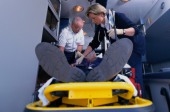
THURSDAY, April 28 (HealthDay News) — More and more Americans over age 55 are working later in life, and this means work-related injuries in this group continue to climb, up from 12 percent in 2003 to 17 percent in the latest tally, federal health officials report.
Although older workers do not have an increased risk of injury overall compared to younger workers, they are at higher risk of falls from stairs, ladders or heights and for specific types of injuries, including fractures and hip injury, the researchers said.
Unless workplaces keep the safety of older workers in mind, injuries will mount as the number of older workers rises from 19 percent to a quarter of the workforce by 2018, according to the researchers from the U.S. Centers for Disease Control and Prevention.
“There is an urgent need for us to look at the safety and health needs of older workers, because they are growing. Employers and others should take steps to help protect the older worker,” said report co-author Dawn N. Castillo, chief of the surveillance and field investigations branch in the division of safety research at the CDC’s National Institute for Occupational Safety and Health.
“We thought it is important to look at injury data to be able to assess if there might be some specific needs in terms of safety and health for the older worker,” she added.
Castillo stressed that the overall rate of injuries suffered by older workers is the same — or even lower — than other age groups.
But since the rates of falls, fractures and hip injuries are higher among older workers, “this points to the need of employers to be aware of these risks and take steps to improve safety of the older workforce,” she said.
Improving safety for older workers will also improve safety for all workers, Castillo said.
The report was published in the April 29 issue of the CDC’s Morbidity and Mortality Weekly Report.
Details for the report were gathered from the U.S. Bureau of Labor Statistics and include all types of workers — from industrial to office and retail and service workers, Castillo said. Many also work in health care and in agriculture. The report also includes statistics for state and local government workers, she said.
In 2009, there were an estimated 210,830 non-fatal work injuries and illnesses among workers 55 and older, which resulted in lost workdays, the researchers found. Most of the injuries (94 percent) were the result of trauma, with chronic injuries, such as back pain and illnesses, making up the rest of the cases.
Men, who make up 52 percent of older workers, accounted for 55 percent of the injuries and also stayed away from work longer than women (14 versus nine days, respectively), according to the report.
Among older workers, rates for falls on the same level — such as falling to a floor, on a walkway, or the ground or against objects such as desks, walls, or doors — increased steadily with age.
However, rates for being “struck by or against, or caught in or crushed by various tools, equipment, machinery, parts, or materials decreased with age,” the report found.
Broken bones accounted for 11 percent of injuries among older workers and were associated with as many as 42 days of missed work. Most of the fractures were to ankles, arms, feet, legs, fingers and hips, the researchers found.
Employers can help reduce injuries by removing tripping hazards and install slip-resistant floors, Castillo said. These and other measures may help reduce injuries and stem the rising tide of injuries among older workers, she said.
Federal researchers also found that work-related highway traffic accidents were the leading cause of fatalities for both workers and the general population, according to another report in the same issue of the Morbidity and Mortality Weekly Report. A total of 8,173 workers died in highway accidents in the United States between 2003 and 2008, representing 24 percent of all occupational deaths during that period, with the highest rates among workers over 65, followed by those 55 to 64.
Most of these accidents involved truckers killed in semi-truck accidents, including jackknifing. The majority of the fatalities were among people who worked in transportation, warehousing and utilities. The second highest rate of deaths were among state and federal government workers, according to the report.
Employers should make road traffic safety a priority, enforcing policies that require use of safety belts and prohibit unsafe behaviors such as impaired driving and use of cell phones and other mobile devices “that might distract the driver while the vehicle is in motion,” the report concluded.
More information
For more on occupational injuries, visit the CDC.

